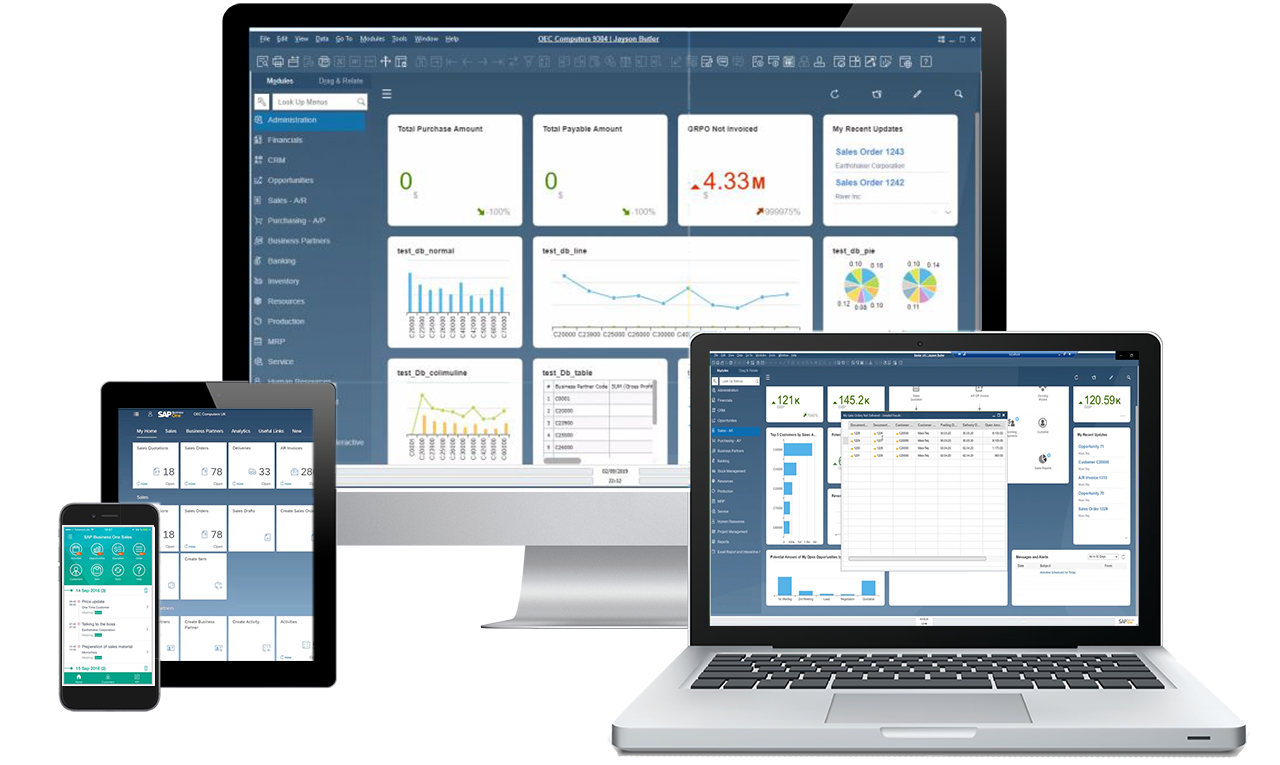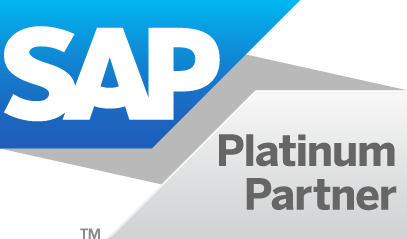We’re about to dive into a heated battle between two giants of the business software world—SAP Business One and Sage. Both are well-established names with a wide range of features that cater to businesses of all sizes, but which one comes out on top for your growing enterprise?
In this article, we’ll take a look at the key differences between the two platforms, including their costs and functionalities. This will help you make an informed decision when it comes to managing your business.
Ready to see how SAP Business One can transform your operations? Contact us today!
The Contenders: SAP Business One and Sage
When evaluating ERP solutions, you must compare the products that serve a similar business size and complexity. For SAP Business One, which targets small to medium-sized enterprises (SMEs), the most comparable competitors from the Sage product portfolio are Sage X3 and Sage 50.
SAP Business One: The All-in-One Solution

SAP Business One (SAP B1) is a comprehensive business management software designed to help SMEs streamline their operations. It offers a range of features such as financial management, sales, customer relationship management (CRM), inventory management, and purchasing, among others.
One of the standout features is its ability to integrate seamlessly with other SAP products, allowing for a more holistic approach to business management. Furthermore, the powerful SAP HANA in-memory platform gives users access to real-time analytics and lightning-fast reporting. With SAP Business One, businesses gain better visibility into their operations, improve decision-making, and ultimately, increase their bottom line.
Also read: SAP Business One Integration Hub
Sage X3: ERP for Mid-to-Large Businesses

Sage X3 is a powerful Enterprise Resource Planning (ERP) software designed for medium to large businesses. It offers a wide range of features, including financial management, inventory management, purchasing, sales, CRM, and production management.
A standout feature of Sage X3 is its scalability, which allows businesses to add new users and features as they grow. Additionally, Sage X3 offers a high degree of customization, letting businesses tailor the software to their specific needs. Consequently, businesses using this Sage ERP solution gain better visibility into their operations, improve collaboration across departments, and ultimately, improve their bottom line.
Sage 50: The Accounting Focus

Sage 50 primarily focuses on providing robust accounting and financial management features for small businesses. While it’s an excellent accounting package, it typically lacks the depth of integrated functionality (like comprehensive CRM, Production, or true multi-warehouse inventory management) that a full-fledged ERP like SAP Business One offers.
Businesses often outgrow the transactional focus of Sage 50 when they require a single system to manage finance, inventory, sales, and operations in a more sophisticated, integrated way.
Comparison Chart: SAP Business One Vs. Sage X3
Let’s compare the two behemoths of the ERP world directly on key factors to see where they stand.
| Factor | SAP Business One | Sage X3 |
| Product Summary | Comprehensive business management software designed for Small to Medium-sized Enterprises (SMEs). | Powerful ERP software designed for Medium to Large-sized Businesses. |
| Overview Pros | User-friendly interface, strong financial management, robust reporting capabilities, strong integration with other SAP products. | Highly customizable, powerful supply chain management, strong financial management, robust reporting capabilities. |
| Overview Cons | Limited native multi-company consolidation (requires add-ons/workarounds), not natively true web-based client for all functions (improving). | Complex user interface, expensive pricing, limited industry focus (natively excels in manufacturing/distribution), limited automation/machine learning capabilities (compared to other high-end ERPs). |
| Customer Ratings (Avg.) | G2: 4.3/5 (529 reviews), Capterra: 4.3/5 (790 reviews), TrustRadius: 7.7/10 (23 reviews) | G2: 3.9/5 (38 reviews), Capterra: 4.0/5 (26 reviews), TrustRadius: 8.0/10 (13 reviews) |
| Deployment | On-premise, Private Cloud, and SAP HANA Cloud | On-premise and True SaaS Cloud (Multi-tenant) |
| Target Business Size | Small to Medium-sized Businesses | Medium to Large-sized Businesses |
| Industry Focus | Broad range of industries, strong partner-driven specialization (add-ons). | Manufacturing, distribution, services (strong native focus). |
| Financial Management | Yes | Yes |
| Inventory Management | Yes | Yes |
| Purchasing | Yes | Yes |
| Sales | Yes | Yes |
| Customer Relationship Management (CRM) | Yes | Yes |
| Features: Production Management | Yes | Yes |
| Supply Chain Management | Yes | Yes |
| Features: Human Resources | Yes (often via partner add-ons/integrations) | Yes |
| Features: Project Management | Yes | Yes |
| Features: Business Intelligence | Yes (SAP HANA excels in real-time reporting) | Yes |
| Integration with Other Systems | Robust (strong SAP ecosystem and APIs) | Limited (compared to SAP’s ecosystem) |
| User Interface | User-friendly, intuitive (Desktop + Web Client) | More complex, steeper learning curve (Modern HTML5 UI) |
| Scalability | Highly scalable (especially with HANA, limited native multi-entity consolidation). | Highly scalable (designed for multi-site/multi-country). |
| Customization | Highly customizable (via Partner SDKs) | Highly customizable |
| Pricing | Subscription-based, varies by features and users. Lower-cost Starter Package available. | Quote-based, varies by features and users. |
| Database Platform | MS SQL or SAP HANA (In-Memory Computing) | MS SQL, Oracle, PostgreSQL (Web-native architecture) |
| Implementation Time | Quick implementation time (as low as 8 weeks) | Longer implementation time (typically starts at 80 days) |
| Multi-Company / Consolidation | Separate databases for each company (requires add-on/manual for consolidation). | Designed for single-database, multi-company/multi-site support. |
Pricing & Value: SAP Business One Vs. Sage
When it comes to pricing, both SAP Business One and Sage X3 offer competitively priced options.
However, SAP Business One offers a significant advantage with its scaled-down SAP Business One Starter Package, which comes at a considerably lower cost compared to the entry point for Sage X3. Furthermore, the total cost of ownership (TCO) often favors SAP B1 for the target SME market.
-
The implementation project scope for SAP Business One can be as low as 8 weeks, meaning you realize ROI faster.
-
In contrast, the typical implementation project scope for Sage X3 starts at 80 days and can scale up based on organizational complexity and functional requirements, extending the time-to-value.
While Sage X3 offers the flexibility of a true SaaS deployment, SAP Business One still comes out as the true winner as far as cost and time-to-value are concerned, providing enterprise-grade functionality at an SME-friendly price point.
Don’t let budget worries hold you back from digital transformation! [Request a B1 price quote] today to see how affordable the best ERP can be.
Why SAP Business One is the Best ERP in Malaysia and Singapore
In the dynamic and competitive markets of Malaysia and Singapore, businesses need a robust, scalable, and locally-compliant ERP system. SAP Business One consistently proves itself as the best ERP solution for SMEs in this region.
Here’s why:
-
Local Compliance: SAP Business One features localizations that ensure compliance with specific regional tax laws (e.g., Malaysia’s e-Invoicing requirements and Singapore’s GST and IRAS filing).
-
Scalability for Growth: SMEs in this region often eye regional expansion. SAP B1 supports multi-currency, multi-language, and multi-entity operations, allowing businesses to expand across ASEAN and beyond effortlessly.
-
Integrated Platform: It gives you a single, unified view of your entire business—from finance and inventory to sales and customer service—eliminating the need for separate, disjointed systems.
Meet Axxis Consulting: Your Trusted SAP Partner
Choosing the right partner is just as critical as choosing the right software. Axxis Consulting stands out as a leading SAP Platinum Partner in both Malaysia and Singapore. They bring local expertise, a strong track record of successful implementations, and dedicated support, ensuring a smooth transition and maximizing your ROI from SAP Business One. They help you go live quickly, minimize downtime, and tailor SAP B1 to your unique business workflows.
The Bottom Line
Both SAP Business One and Sage X3 are powerful ERP solutions. You need to choose the one that aligns best with your business size and growth trajectory.
-
If you are a mid-to-large enterprise with highly complex, global operations and deep multi-site consolidation requirements, SAP S/4HANA Public Cloud or Sage X3 may be suitable.
-
If you are a growing SME in Malaysia or Singapore looking for an all-in-one, integrated, affordable, and scalable ERP solution with fast implementation and excellent local support, SAP Business One is the clear victor.
SAP Business One offers a more flexible solution, a quicker implementation time, and a lower-cost starter package, making it the superior choice for ambitious SMEs ready to take the next step.














